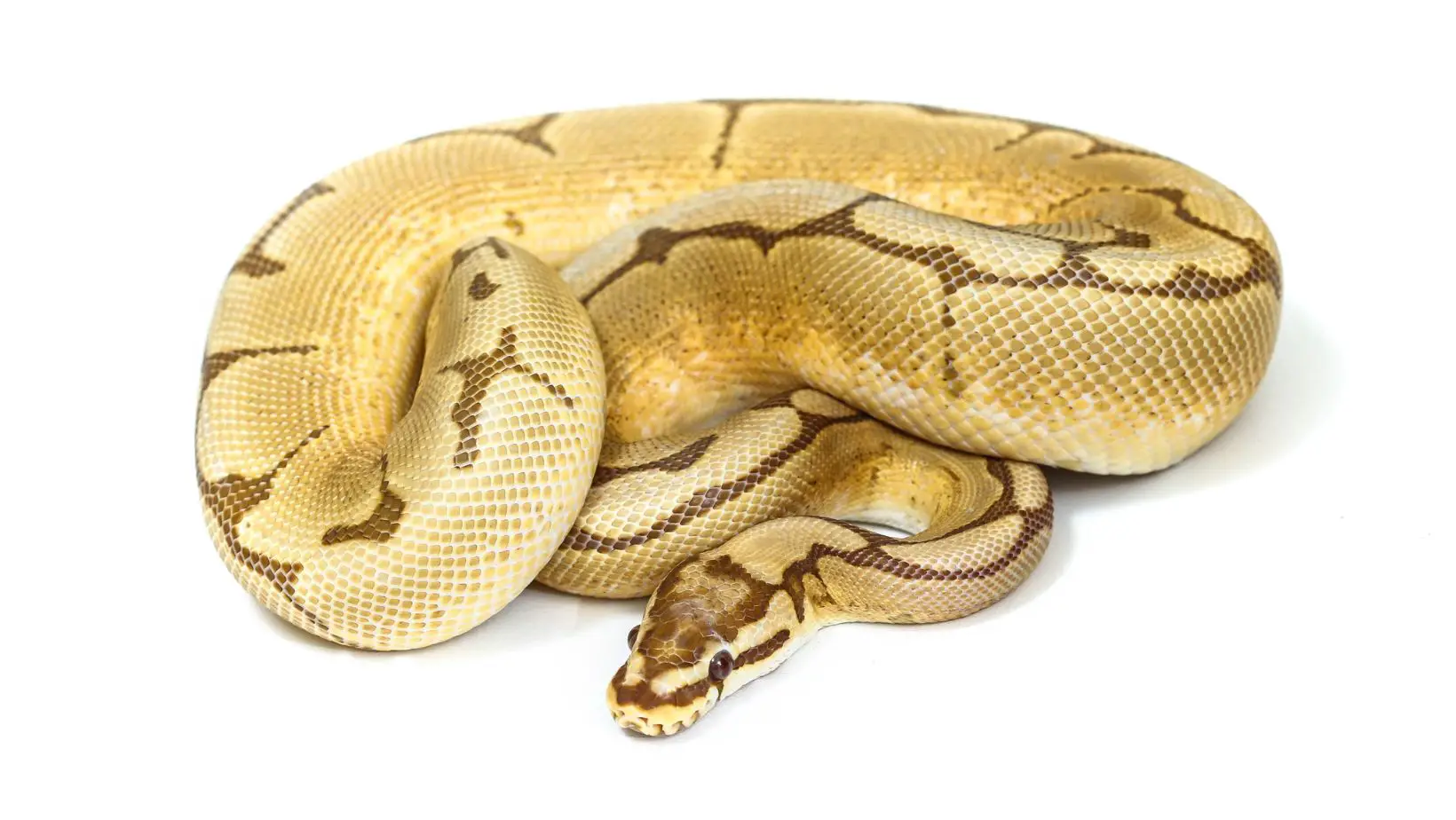The Banana Pastel Ball Python is a popular morph known for its vibrant yellow coloration and beautiful pattern. It combines the Banana and Pastel morphs, resulting in a snake with unique and visually appealing characteristics.
Overview of the Banana Pastel Ball Python:
Physical Characteristics and Appearance: Coloration: Banana Pastel Ball Pythons display a bright yellow coloration with varying degrees of intensity. The yellow color is usually dominant throughout their body, giving them a striking appearance.
Pattern: The pattern of Banana Pastel Ball Pythons is typically reduced compared to the wild-type or “normal” ball python. The reduced pattern allows the vibrant yellow color to stand out even more.
Size: Like other ball pythons, the size of Banana Pastel Ball Pythons can vary. They generally reach an adult length of around 3 to 5 feet (0.9 to 1.5 meters), with females being slightly larger than males.
Comparison to Other Ball Python Morphs: Compared to other ball python morphs, the Banana Pastel Ball Python stands out due to its distinctive yellow coloration and reduced pattern. It is highly sought after by reptile enthusiasts and breeders for its unique appearance.
History of Banana Pastel Ball Pythons: The Banana Pastel Ball Python is a relatively new morph that was first produced by breeders in the late 1990s. It was created through selective breeding to combine the traits of the Banana and Pastel morphs.
Genes that Make a Banana Pastel Ball Python: The Banana Pastel Ball Python is a result of combining the genes of the Banana and Pastel morphs. The Banana gene is responsible for the vibrant yellow coloration, while the Pastel gene enhances the overall brightness and reduces the pattern.
Caring for a Banana Pastel Ball Python:
Housing: Provide a suitable enclosure that is appropriately sized for the snake, allowing enough space for movement and providing hiding spots. A 20-gallon tank or larger is typically recommended for adult Banana Pastel Ball Pythons.
Bedding: Use suitable substrates such as aspen shavings, cypress mulch, or reptile carpet for the enclosure floor. Avoid using substrates that can retain excessive moisture, as it may lead to respiratory issues.
Temperature and Humidity: Maintain a temperature gradient within the enclosure, ranging from 75°F (24°C) on the cooler side to 90°F (32°C) on the warmer side. Use heat sources like heat lamps or heat pads to achieve the desired temperatures. The humidity level should be kept between 50% and 60%.
Feeding: Feed Banana Pastel Ball Pythons appropriately sized rodents, such as mice or rats. The prey size should be no larger than the snake’s thickest part. Offer food every 1-2 weeks for juveniles and every 2-3 weeks for adults.
Handling and Socialization: Handle your Banana Pastel Ball Python with care and ensure proper support. Gradually introduce handling sessions to allow the snake to become accustomed to human interaction. Regular, gentle handling can help promote socialization and reduce stress.
Health Concerns: Banana Pastel Ball Pythons are generally hardy, but they can still be prone to health issues. Common concerns include respiratory infections, mites or ticks, shedding problems, and digestive issues. Regular health checks by a reptile-experienced veterinarian and proper husbandry can help prevent and address these issues.
Breeding Banana Pastel Ball Pythons:
Age: Female Banana Pastel Ball Pythons should reach a minimum weight of around 1500 grams before breeding, which typically occurs at around 2-3 years of age. Males can breed at smaller sizes and younger ages.
Size: Breeding should only be attempted when both the male and female are of adequate size and weight. The female should be larger than the male to ensure a successful breeding process.
Housing: Provide separate breeding enclosures for the male and female snakes, and introduce them during the breeding season. Monitor their behavior and separate them if any aggression or stress is observed.
Diet: Prior to breeding, ensure that both the male and female snakes are in optimal health and have been consistently fed a balanced diet.
Time Period: Breeding typically occurs during the cooler months, mimicking the natural breeding season. Breeding attempts can be made over a period of several weeks to increase the chances of successful copulation.
Incubation: After successful breeding, collect the eggs and place them in an incubator set to appropriate temperature and humidity levels. The incubation period is typically around 55-60 days, after which the eggs hatch.
Banana Pastel Ball Pythons Cost:
The cost of Banana Pastel Ball Pythons can vary depending on factors such as age, size, and lineage. Generally, they are considered to be in the mid-range of ball python morph prices. Prices can range from around $200 to $600 or more, with higher-end specimens commanding higher prices.
Advantages and Disadvantages of Owning a Banana Pastel Ball Python:
A. Advantages:
- Striking and unique yellow coloration
- Reduced pattern enhances the visual appeal
- Popular and sought-after morph among reptile enthusiasts
- Relatively hardy and easy to care for
- Can be a rewarding breeding project for experienced breeders
B. Disadvantages:
- Initial cost can be higher compared to some other morphs
- Requires proper husbandry and care to maintain health and well-being
- Long lifespan requires a long-term commitment
- May not be suitable for individuals looking for a more subtle or natural appearance
Conclusion:
Banana Pastel Ball Pythons are highly sought-after pets due to their vibrant yellow coloration and reduced pattern. They can make wonderful pets for reptile enthusiasts with proper care and attention to their housing, feeding, and overall health. The unique appearance and relatively easy care requirements make the Banana Pastel Ball Python popular for snake owners looking for a visually striking and captivating pet.


